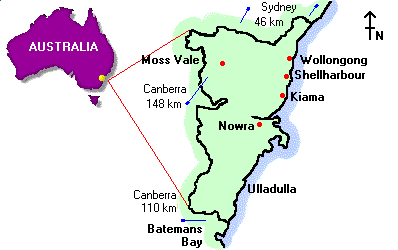TICKS IN THE ILLAWARRA REGION of NSW
The Illawarra region includes Wollongong city, Shellharbour and Kiama shires as well as Shoalhaven and Wingecarribee shires. Wollongong is the regions capital city. The word "Illawarra" is derived from the Aboriginal Koori language and means 'where the mountains meet the sea', and the name "Wollongong" comes from an Aboriginal word meaning "sound of the sea".
 |
Easily the most common tick found on humans and pets in this region is in fact the paralysis tick, Ixodes holocyclus. Because this tick has many morphologies in both it's life cycle stages and in it's degrees of engorgement, people may incorrectly assume that they are finding many different kinds of ticks on their animals.
Larval stage paralysis ticks in particular look very different- they have only six legs compared with the nymph and adult stages' eight. They are very small until engorged, easily removed and they break easily, releasing blood when squeezed. They may be present in huge numbers- in fact in the hundreds. See pictures of larvae.
The web author [NF] has only occasionally seen the brown dog tick and the bush tick on dogs in the Illawarra. The bush tick is mostly seen on dogs associating with farm animals. To identify these see Distinguishing Common Ticks on the East Coast of Australia.
If, therefore any ticks are found on a pet in this region, one should assume they are paralysis ticks until proven otherwise and take precautions. If larval or nymph stages are being found then several months later an outbreak of the more dangerous adult ticks can be expected. See also pictures of nymphs and adults.
In the Illawarra, most adult paralysis ticks are found on animals around Spring (i.e. from August to December). Hot dry conditions see the numbers decline gradually after January.
Sporadic cases will occur even during mid winter when conditions are moist. Note that it is only temperatures below 7 degrees that are lethal to paralysis ticks- thus in humid sheltered areas ticks may easily survive the winter in this region.
Most owners with yards adjacent the Illawarra escarpment bushland report finding ticks on both themselves and their animals when conditions are favourable. Backyards are commonly "trespassed" by bandicoots and brushtail possums which may leave ticks behind. Trees overhanging yards may drop ticks into the yard- it is not unheard of that ticks are brought into the house on clothes hung out to dry! The urban, but leafy suburb of Mangerton has its own resident native fauna and hence paralysis tick problems. Another common problem is that of pets visiting the South Coast or North Coast during vacations and returning to suburbia only to suffer paralysis 4+ days later.
PS: If anyone can specifically let me know in which parks and reserves they are finding animals with ticks, I will add such information to this page.
The Paralysis Tick of Australia - Home
E-mail Us to report a broken link!